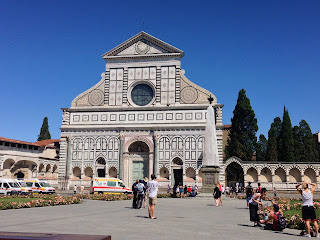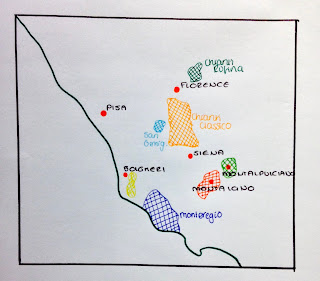A day trip to Certaldo
Sometimes it's nice to escape the city, and find somewhere with a bit of a slower pace than Florence. On my ever growing list of places to visit across Tuscany and beyond was Certaldo. A little Tuscan town, around 45 minutes from Florence by train, and seemed like a great day trip into the countryside. Split into two parts; Alto (upper part) and Basso (lower part); Certaldo Basso is where the train station is, and the more modern amenities; restaurants, cafes, bars and shops etc. whereas the medieval Certaldo Alto is like a place stuck in time - and best reached by the cable car!
It's a timeless and peaceful place, with barely any visitors when I visited (a beautifully sunny January morning), but I can't imagine it ever gets overly busy, even in the high season. It's a town full of beautiful historical buildings and local curiosities, and perfect for those who are looking for a peaceful getaway.
The most interesting bits are found in Certaldo Alto, and I will obviously recommend getting the cable car up, but it's also an easy, short walk. My top recommendation is to visit the Casa del Boccaccio, if your a big fan of the man (find more about him below). This was the site of the Boccaccio's home of the last part of his life (it was reconstructed in the original style after having been virtually totally destroyed by Allied bombing during the Second World War. Nowadays it's home to objects related to the writers life, alongside many of his rare and valuable editions of his works. Make sure to visit the top floor you can marvel over the amazing view over the Valdelsa! With a single ticket you can enter this great little museum/library dedicated to his works, along with entrance to the Museum of Sacred Art and the Palazzo Pretorio, all found on via Boccaccio.
On the same street you can find the Church of Jacopo and Filippo, one of the most important religious buildings of the town. The Romanesque church has a few points of interest; the resting place of Giovanni Boccaccio, who was a great 14th century writer (only discovered in the mid 1800's!) and the remains of the Blessed Giulia della Rena; a religious women who lived as a hermit during the 14th century and spent her life praying in a cell in Certaldo. A 13th century wooden crucifix of Petrognano is also found in this church, and 2 ciboria either side of the apse - one by Benedict Buglioni in the late 15th century, and the other by the workshop of Andrea della Robbia in the 16th century. Opposite the church is a beautiful cloister and and the Augustinian monastery, which today houses the Museum of Sacred Art.
The Church of Saints Tommaso and Prospero is another interesting space with its' degraded appearance due to the unstable hillside. The fresco cycle of the story of The Passion by Benozzo Gozzoli, and the Tabernacle of the Condemned Prisoners.
Make sure to visit the Palazzo Pretorio, which originally was the residence of the Conti Alberti family in the 12th century, who were known for their aggressive behaviour in claiming land, and their many confrontations with the Florentines. It then became the residence of Florentine governors and acted as a symbolic place of the civil power. The facade is most unusual, and perfect for a photo opportunity; decorated with numerous coats of arms, many of which were produced by the della Robbia family. Once serving as a town prison, nowadays admire the various frescoes from the 13th to 16th century - look out for the fresco of Doubting Thomas by Benozzo Gozzoli in the small chapel, the Madonna and Child (1489) by Pier Francesco Fiorentino, a Crucifixion (1478) and a Pietà. There's also a space dedicated to temporary exhibitions of more contemporary local artists which is a nice break for all the history overload, as well as a Zen garden with a cute little Japanese tea house!
Who was Boccaccio?
Born around 1313 in Certaldo, Giovanni Boccaccio was one of the most important poems of his time, and alongside Dante and Petrarch came known to be one of the three crowns of of the Italian literary language - Fiorentina. He wrote numerous works, mainly in the Italian vernacular each in his very unique style considered very modern at the time. He is best known for The Decameron, which comprised of 100 tales told by a group of 7 young women, and 3 men staying in a villa outside Florence to escape the Black Death. It really is a great read, full of love stories, tragedies and valuable life lessons with a great humour.
Next up on the blog is my mini break to Palermo in Sicily which complete stole my heart - up in the next few days!
It's a timeless and peaceful place, with barely any visitors when I visited (a beautifully sunny January morning), but I can't imagine it ever gets overly busy, even in the high season. It's a town full of beautiful historical buildings and local curiosities, and perfect for those who are looking for a peaceful getaway.
On the same street you can find the Church of Jacopo and Filippo, one of the most important religious buildings of the town. The Romanesque church has a few points of interest; the resting place of Giovanni Boccaccio, who was a great 14th century writer (only discovered in the mid 1800's!) and the remains of the Blessed Giulia della Rena; a religious women who lived as a hermit during the 14th century and spent her life praying in a cell in Certaldo. A 13th century wooden crucifix of Petrognano is also found in this church, and 2 ciboria either side of the apse - one by Benedict Buglioni in the late 15th century, and the other by the workshop of Andrea della Robbia in the 16th century. Opposite the church is a beautiful cloister and and the Augustinian monastery, which today houses the Museum of Sacred Art.
The Church of Saints Tommaso and Prospero is another interesting space with its' degraded appearance due to the unstable hillside. The fresco cycle of the story of The Passion by Benozzo Gozzoli, and the Tabernacle of the Condemned Prisoners.
Make sure to visit the Palazzo Pretorio, which originally was the residence of the Conti Alberti family in the 12th century, who were known for their aggressive behaviour in claiming land, and their many confrontations with the Florentines. It then became the residence of Florentine governors and acted as a symbolic place of the civil power. The facade is most unusual, and perfect for a photo opportunity; decorated with numerous coats of arms, many of which were produced by the della Robbia family. Once serving as a town prison, nowadays admire the various frescoes from the 13th to 16th century - look out for the fresco of Doubting Thomas by Benozzo Gozzoli in the small chapel, the Madonna and Child (1489) by Pier Francesco Fiorentino, a Crucifixion (1478) and a Pietà. There's also a space dedicated to temporary exhibitions of more contemporary local artists which is a nice break for all the history overload, as well as a Zen garden with a cute little Japanese tea house!
Who was Boccaccio?
Born around 1313 in Certaldo, Giovanni Boccaccio was one of the most important poems of his time, and alongside Dante and Petrarch came known to be one of the three crowns of of the Italian literary language - Fiorentina. He wrote numerous works, mainly in the Italian vernacular each in his very unique style considered very modern at the time. He is best known for The Decameron, which comprised of 100 tales told by a group of 7 young women, and 3 men staying in a villa outside Florence to escape the Black Death. It really is a great read, full of love stories, tragedies and valuable life lessons with a great humour.
Next up on the blog is my mini break to Palermo in Sicily which complete stole my heart - up in the next few days!







Comments
Post a Comment